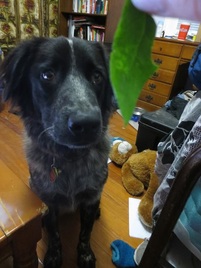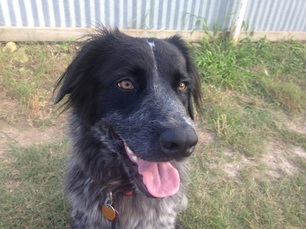 Imagine this: You go to work every day. Forty hours a week, you do everything your boss asks of you. At the end of the month, instead of a paycheck, your boss says, “You did what you were supposed to do because I’m your boss.” Would you be motivated to go back to work and do a good job? There are a few common complaints that all reward-based trainers hear: “I don’t want to bribe my dog to get them to listen to me.” “My dog should work for me just because they love me!” “My dog doesn’t even like treats.” All of these are closely linked to one of the most important elements of training: Motivation. So, think back to the work scenario. Would you be more likely to do a good job if your boss was complimenting you when you worked hard? How about if he or she was giving you a bonus when you did a particularly good job? The concern over using treats with our dogs has some validity. Many people use treats incorrectly in training, sometimes creating dogs who will only work when food is visible or who constantly need a high rate of reinforcement. There are a few simple things you can do to prevent these issues. First of all, try to keep treats out of sight until AFTER the dog has done a behavior you want to reward. This can be accomplished by keeping treats in a pouch or pocket and by using a marker. A marker can be a click from a clicker or a word like “yes” that lets your dog know the moment they have done the right thing – it’s like taking a picture of the good behavior. Once the dog realizes this word or sound means they have done something good and they will be getting a reward, they will immediately associate the sound with the right behavior and you have a buffer to get the treat out after the marker happens. What does this look like in an actual training session? Say you are teaching a sit. As soon as the dog sits down, you click or say “yes,” and then get a treat out of your bag and offer it to them. Cue, marker, reward. So the dog is still being reinforced for the behavior, but you don’t have to have a treat ready to get them to listen to a cue. Secondly, vary your rewards. If you give the same treat every time, the same way, the dog may learn but they will fall into a pattern and expect the treat, or they may get bored with training. If you use different rewards, and vary how often and how much you reward, your training will be much more effective. So, for example, you may reward with a treat one time, a toy the next time, a jackpot of treats for a really good behavior, and maybe a bit of praise or attention for something still good but not as important or precise. This is also linked to the “But my dog doesn’t like treats!” issue. All dogs need food, so food is always a reinforcer. But it is true that some dogs like food more than others. Dogs who are not as treat motivated may benefit from working for their food throughout the day instead of having it fed to them in meals. It is also a good idea to have a variety of high-value food options like hot dogs, cheese, freeze-dried liver and lung, or boiled chicken available to reinforce in distracting situations or for really great behaviors. But why use food at all? This goes back to the work example. Your dog may love you, but if you want them to consistently and excitedly listen to your cues it is important that they are motivated to do so. There are a lot of distractions in the world, and because they see us every day, it is easy for those distractions to become more exciting than listening to you. Is the normal attention you give them every day more exciting than a squirrel or another dog? For some dogs it may be, but for most dogs, the squirrel is going to win out every time. Cues taught with rewards the dog values, practiced consistently until they become almost automatic, are much more likely to hold up in exciting real-life situations. This does not mean the rewards always have to be food: anything the dog values can be a reward. Food tends to be the highest value reward for most dogs, but if they love toys, attention, petting, play, movement – any of these can be used as to reinforce them for good behavior. Think about it this way, too: You may be happy to do a favor for a family member or friend because you care about them, but if they are constantly asking for favors without giving you anything in return, you may start to feel frustrated or avoid responding to their requests. So, yes, your dog may do things for you because they love you; but they deserve a little love and reinforcement in return.
1 Comment
 If you're reading this blog, or on my website at all, you probably have a dog, or love dogs, or are just interested in dog behavior. Welcome! A little about me: I'm a dog trainer in the Austin area. I've had dogs my entire life, and they've always been family. When I started training several years ago, I had recently graduated from the University of Texas with a Master of Arts in Journalism, and while I was applying for jobs in that field, I didn't feel the passion that I felt working with dogs. I decided to ignore my degree and follow my heart to dog training, and I never looked back. Currently, my "day job" is training service dogs with a fantastic non-profit. By night (and on weekends), I offer private lessons covering a variety of behaviors, but especially love working with dogs that other people consider difficult - dogs who are reactive, or fearful, or aggressive. I love figuring out each dog's unique strengths and how to help them reach their full potential. I hope that this blog can be a place for me to detail my journey, particularly with my own long-term project dog, Percy, and provide help to others and their dogs along the way. I'll try to post training tips about once a week on a variety of subjects (feel free to request topics in the comments here or on my Facebook page!). So again, welcome - Look for another post in the next few days with my first training tips, and if you aren't already, follow me on Facebook to keep up-to-date on everything going on in the doggie world. |
Sarah Bond
Sarah is a Certified Dog Behavior Consultant and Certified Professional Dog Trainer - Knowledge and Skills Assessed. She lives in the Texas Hill Country near Austin with her two dogs, Percy, a cattle dog mix, and Clara, a lab/German Shepherd. Archives
October 2020
Categories |
 RSS Feed
RSS Feed